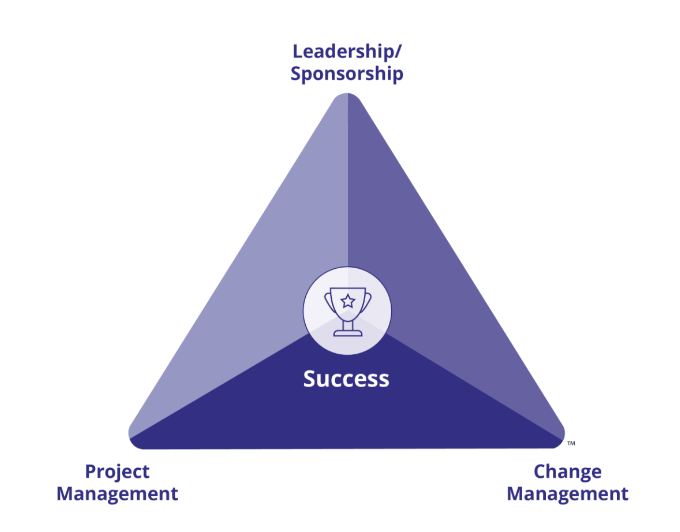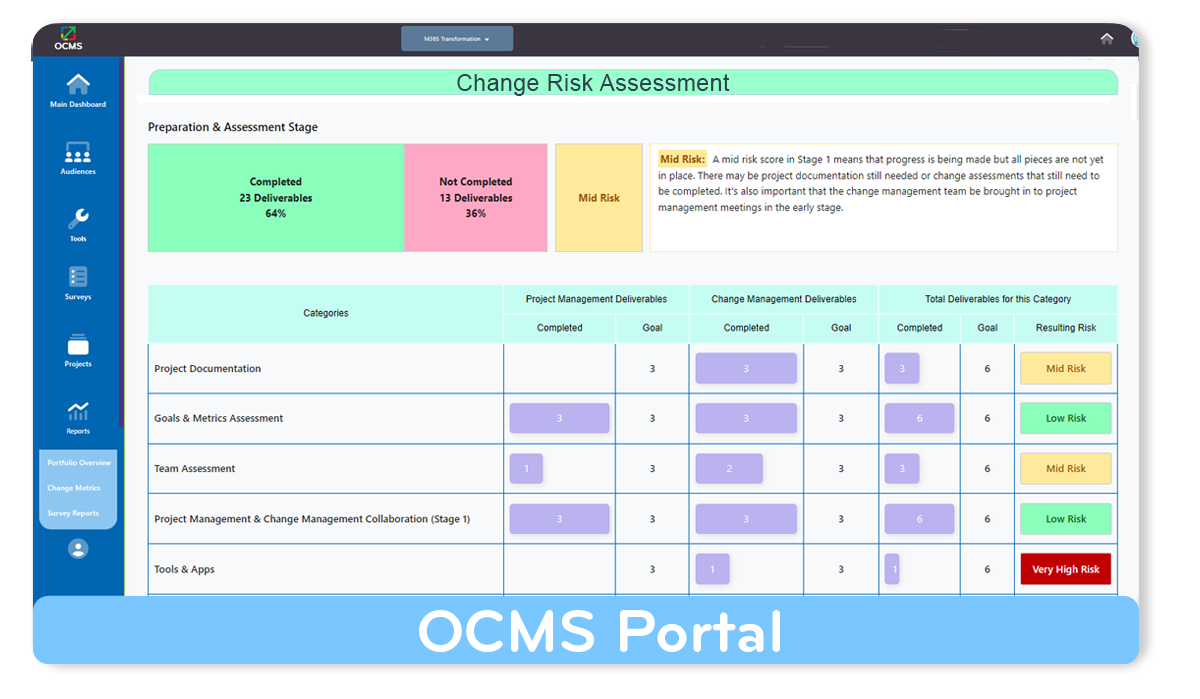Prosci Project Change Triangle
(3 Success Factors)
The Key Pillars Needed for a Change to Be Successful in 2024
 Success in change management relies on a blend of thoughtful strategy and empathetic leadership. Having dedicated and visible leadership championing the change sends a powerful message of commitment and enthusiasm, inspiring others to hop on board.
Success in change management relies on a blend of thoughtful strategy and empathetic leadership. Having dedicated and visible leadership championing the change sends a powerful message of commitment and enthusiasm, inspiring others to hop on board.
You also need to have technical deployment. This is handled by the Project Management Team, and it encompasses the planning, development, and deployment of the technical aspects of the project.
The third key element of the change triangle is user adoption of the project solution. Here, the Change Management Team engages with those groups and individuals being impacted by changes from the project through communication, training, and support, and in other ways to ensure that they make the necessary changes the required changes successfully.
Ultimately, success in change management is not just about crossing the finish line but about the collective experience of the journey and the positive transformation it brings to individuals and the organization as a whole.
What Is the Prosci Project Change Triangle?
The Prosci Change Triangle (PCT) Model is a strategic framework that plays a pivotal role in guiding organizations through successful change initiatives. At its core, this triangle of change comprises three crucial elements, along with success components of a project.
- Leadership/sponsorship
- Project management
- Change management
- Success components (project goals, reason for the change)
These components work synergistically to address the multifaceted nature of organizational change, ensuring a comprehensive and well-coordinated approach. Leadership/sponsorship represents the executive support and commitment necessary for any change effort to succeed. Project management, the second facet of the change management pillars, focuses on the technical aspects of change. The third corner, change management, deals with the people side of change. Success components act as a compass for the other three.
By addressing these dimensions concurrently, the Prosci Change Triangle attempts to provide a holistic framework that enhances the likelihood of successful and sustainable organizational change.
What is the Change Triangle? Breakdown of All Change Management Pillars
Each part of the Prosci project change triangle represents a critical aspect that must be effectively addressed for a project to be delivered successfully. These different change management pillars can provide organizations guidance as they approach various change initiatives.
The Prosci change triangle is also adaptable to any size or type of change initiative because it gives an general overarching view of factors to keep in mind when planning any project that impacts the way people do things.

Image credit: Prosci Change Triangle – PCT Model
In the sections below, we’ll go through each aspect of the Prosci change triangle in more detail.
Looking for a comprehensive Change Risk Assessment Tool? Try OCMS Portal!

OCMS Portal is an end-to-end change management software that can handle all aspects of OCM support for a project. It includes a simple but effective Change Risk Assessment tool, which incorporates project management and change management deliverables. Learn more here.
Success
The middle of Prosci’s triangle of change is Success. This emphasizes the factors that make up what is necessary for the project to be considered successful. These components typically include things like:
- Reason for the project
- Objective and goals for the organization
- Benefits that the project is designed to provide
These success components are the target that the three vertexes of the Prosci change triangle (Leadership, Project Management, Change Management) need to keep in mind as they accomplish their project deliverables.
Leadership/Sponsorship
The first vertex of the project change triangle, Leadership/Sponsorship, underscores the importance of strong and committed leadership throughout the change process. A project’s success hinges on the active involvement and support of organizational leaders who not only champion the initiative but also allocate necessary resources and foster a culture conducive to change. Effective leadership ensures that the vision and goals of the project are clearly communicated and aligned with the overall strategic direction of the organization. Strong and visible leadership creates a sense of urgency, fosters alignment with organizational goals, and empowers employees to embrace the impending changes.
Don’t Miss: What are the Benefits & Importance of Change Management
Leaders are needed to continuously and publicly champion the change program, as well as establish priority, governance, and vision.
Project Management
The next of the change management pillars, Project Management, emphasizes the significance of sound project management principles. This involves ensuring that the project is well-planned, executed, and controlled. Factors such as defining scope, managing resources, and adhering to timelines are crucial for project success. Project managers must be adept at balancing competing priorities, mitigating risks, and adapting to unforeseen challenges. This involves the planning, execution, and monitoring of the project, ensuring that it stays on schedule, within budget, and meets its objectives.
Change Management
The third of the pillars of change management triangle, Change Management, recognizes the human side of change. It involves understanding and addressing the impact of the project on individuals within the organization. Successful change management requires effective communication, stakeholder engagement, and the implementation of strategies to address resistance.
By focusing on these interconnected aspects, the Prosci Change Triangle provides a comprehensive framework for project success that considers both the technical and human elements essential for achieving positive outcomes.
See Also: Best Change Management Methodologies and Processes
FAQ: Prosci Project Change Triangle
What is the change triangle by Prosci?
The Prosci Change Triangle (PCT) Model pillars of change management is a strategic framework that plays a pivotal role in guiding organizations through successful change initiatives. At its core, this triangle of change comprises three crucial elements, Leadership, Project Management, and Change Management. The center of the triangle highlights the components making up project success.
What do the Prosci change management pillars do?
These components work synergistically to address the multifaceted nature of organizational change, ensuring a comprehensive and well-coordinated approach.
Note: Content on OCM Solution's ocmsolution.com website is protected by copyright. Should you have any questions or comments regarding this OCM Solutions page, please reach out to Ogbe Airiodion (Change Management Lead) or the OCM Solutions Team today. OCM Solution was previously known as Airiodion Global Services (AGS).
External sources: stock.adobe.com, https://www.prosci.com/methodology/pct-model



